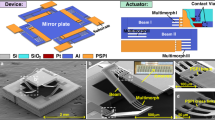Abstract
This paper presents modelling, fabrication and testing of a torsional micromirror suspended by two compliant ortho-planar springs attached at the sides. The proposed cantilevered serpentine spring is a single-chain frame, composed of nine beam segments to form a serpentine together with an initial segment and a final segment. Castigliano theory is used to formulate the spring constants under certain loads. Two equivalent spring constants for the micromirror are obtained according to structure analysis. The 2-DOF model for torsion and bending of the micromirror is presented. Finite element analysis (FEA) of the coupled domain of the structure is performed to verify the analytical results. Further validation of the prediction is carried out through static testing of a fabricated micromirror using a PSD (position sensing detector) sensor based experimental set-up. Due to relative compliancy of the dominant torsion mode, the fabricated micromirror is actuated to some angle at a lower voltage. The comparison between FEA and analytical results shows good agreement, demonstrating the accuracy prediction by the derived model. Small deviation from experiments is expected due to the nonlinear nature of electrostatic field.











Similar content being viewed by others
References
Zhang XM, Chau FS, Quan C, Lam YL, Liu AQ (2001) A study of the static characteristics of a torsional micromirror. Sens Actuators A 90:73–81
Hsieh J, Fang WL (2000) A novel microelectrostatic torsional actuator. Sens Actuators 79:64–70
Kamiya D, Gozu T, Horie M (2005) Design and manufacturing of micromechanism elements of 2-DOF micromanipulator. Microsyst Technol 11:1013–1019
Yoon YS, Bae KD, Kim JH, Choi H (2003) A low voltage actuated micromirror with an extra vertical electrode for 90° rotation. J Micromech Microeng 13:922–926
Fedder G (1994) Simulation of micro-electro-mechanical systems, PhD Dissertation, University of California at Berkeley
Cheng Y-C, Dai C-L, Lee C-Y et al (2005) A MEMS micromirror fabricated using CMOS post-process. Sens Actuators A 120:573–581
CMC Microsystems, Micralyne (2004) Introduction to micraGEM: a silicon-on-insulator based micromachining process v3.0
Ji CH, Choi MG et al (2006) An electrostatic scanning micromirror with diaphragm mirror plate and diamond-shaped reinforcement frame. J Micromech Microeng 16:1033–1039
Barillaro G, Molfese A et al (2005) Analysis, simulation and relative performances of two kinds of serpentine springs. J Microelectromech Syst 15:736–746
Bachmann D, Schoberle B, Kuhne S, Leiner Y, Hierold C (2006) Fabrication and characterization of folded SU-8 suspensions for MEMS applications. Sens Actuators A 130–131:379–386
Tsou CF (2006) The design and simulation of a novel out-of-plane micro electrostatic actuator. Microsyst Technol 12:723–729
Chu PB, Brener I, Pu C et al (2005) Design and nonlinear servo control of MEMS mirrors and their performance in a large port-count optical switch. J Microelectromech Syst 14:261–273
Huang JM, Liu AQ et al (2004) An approach to the coupling effect between torsion and bending for electrostatic torsional micromirrors. Sens Actuators A 115:159–167
Cheng J, Zhe J, Wu XT (2004) Analytical and finite element model pull-in study of rigid and deformable electrostatic microactuators. J Micromech Microeng 14:57–68
Degani O, Nemirovsky Y (2004) Experimental verification of a design methodology for torsion actuators based on a rapid pull-in solver. J Microelectromech Syst 13:121–129
Zhao JP, Chen HL (2005) A study on the coupled dynamic characteristics for a torsional micromirror. Microsyst Technol 11:1301–1309
Jung K, Lee J, Choi B (2001) Numerical analyses of the micromirror for projection TV using FEM. Microsyst Technol 7:75–79
Zhao JP, Chen HL, Huang JM, Liu AQ (2005) A study of dynamic characteristics and simulation of MEMS torsional micromirrors. Sens Actuators A 120:199–210
Yan D, Apsel A, Lal A (2005) Fabrication and electromechanical characterization of silicon on insulator based electrostatic micro-scanners. Smart Mater Struct 14:775–784
Acknowledgments
The support received from Natural Sciences and Engineering Research Council of Canada, Canadian Microelectronics Corporation (CMC) Microsystems and Micralyne is acknowledged.
Author information
Authors and Affiliations
Corresponding author
Rights and permissions
About this article
Cite this article
You, J., Packirisamy, M. & Stiharu, I. Study of an eletrostatically actuated torsional micromirror with compliant planar springs. Microsyst Technol 14, 7–16 (2008). https://doi.org/10.1007/s00542-007-0396-z
Received:
Accepted:
Published:
Issue Date:
DOI: https://doi.org/10.1007/s00542-007-0396-z




